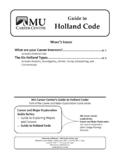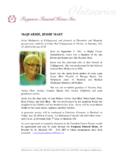Transcription of Medication Reconciliation Toolkit - NC Quality Center
1 Medication SAFETY RECONCILIATIONTOOL KIT1 Medication Safety ReconciliationDeveloped by the North Carolina Center for hospital Quality and Patient Safety September 2006PO Box 4449, Cary, NC 27519-4449 Portions of this Tool Kit are reproduced with permission of The Carolinas Center for Medical Excellence October 2005. The Carolinas Center for Medical Excellence, 100 Regency Forest Drive, Suite 200, Cary, NC 27511-8598 Medication SAFETY RECONCILIATIONTOOL KIT2 North Carolina Centerfor hospital Quality and Patient SafetyAcknowledgements Thanks to those that have shared their time and expertise to help develop and producethis tool kit. It is through their expertise, creativity and generosity of sharing their knowl-edge and forms that we have been able to produce this tool kit for your use. Specifically, thank you to:Frank FedericoDirectorInstitute for Healthcare ImprovementCambridge, MAEric Jackson, MALead Analyst The Carolinas Center for Medical Excellence Cary, NC Meera Kelley, MDVP Quality and Patient SafetyWakeMed Health and HospitalsRaleigh, NCCarol Koeble, MD, MS, CPED irectorNC Center for hospital Quality and Patient SafetyVice PresidentNorth Carolina hospital AssociationCary, NCDebra Miller, PharmD, BCPSC ardiology Clinical SpecialistCarolinas Medical CenterCharlotte, NCErica Morrison, MSProject ManagerNC Center for hospital Quality and Patient SafetyNorth Carolina hospital AssociationCary, NCRyan M.
2 Taylor, PharmDMedication Safety OfficerOSF Saint Francis Medical Center Peoria, IlAdditionally, thank you to the Institute for Healthcare (IHI) and The Carolinas Center for Medical Excellence (CCME) for their materials. Barbara S. Edson, RN MBA, MHAQ uality Improvement and Patient Safety Professional/ConsultantNC Center for hospital Quality and Patient SafetyNorth Carolina hospital AssociationCary, NC 3 Medication Safety ReconciliationChapter 1: IntroductionChapter 2: Assessment Chapter 3: The ProjectChapter 4: Performance Improvement ModelChapter 5: Spreading and FormalizingChapter 6: Reference MaterialsTable of Contents4 North Carolina Centerfor hospital Quality and Patient SafetyThe ProblemA 72-year old female with a history of heart disease and atrial fibrillation was admitted to the hospital with pneu-monia. Her prior medications included Warfarin 3mg daily, Lipitor 10mg daily, and Toprol XL 100mg in the hospital she was under the care of the hospitalist physicians.
3 She received Pravachol instead ofLipitor as the hospital had a deal with the company to get Pravachol at much lower cost. Her PT (protime)became elevated while receiving the antibiotic Levofloxacin, and her Warfarin dose was decreased to 2mg discharge home, her physician wrote to D/C home on current meds, and she received a list and correspon-ding prescriptions for Coumadin 2mg by mouth daily, Pravachol 40mg by mouth daily, Toprol XL 100mg bymouth daily and Levoquin 500mg by mouth daily for 5 days. Ten days later she returned with severe body aches,weakness and bright red blood per rectum. Her laboratory evaluation revealed a hemoglobin of , CPK of3200, and a PT of 44. Her bag of medications included Coumadin 2 mg daily, Warfarin 3mg daily, Pravachol40 mg daily, Lipitor 10 mg daily, and Toprol XL 100 mg daily. When asked why she was taking the Warfarinand the Lipitor when they weren't on her discharge list, she explained that they had been prescribed by her cardi-ologist who told her it was very important to keep taking these.
4 Fortunately, her excess blood thinning and choles-terol lowering medications were stopped and she recovered completely. She was given a list of medications thatalso clearly specified which medications were to be stopped, and the information was communicated by phoneand fax to the cardiologist with whom she was to follow up. Unfortunately, scenarios like this one are far too common in our healthcare system. It has been estimated that approxi-mately 7,000 of these deaths are attributable to Medication errors. 1 Medication delivery in the hospital environment is a complex process consisting of prescribing, transcription, dispensingand administration. Errors can and do occur during any step of this process. Over half (56%) of Medication errorsoccur during the prescribing process. 6 Medication errors occur 46% of the time during transitions, admission, transferor discharge from a clinical unit / hospital . 7 Introduction1 Scope of the Problem Incidence rates of adverse drug events (ADEs) range from 2 to 7 per 100 Preventable adverse drug events are associated with one out of five injuries or deaths from errors, and are a result ofpoorly designed systems, which often lack independent Medication errors are one of the leading causes of injury to hospital patients.
5 Chart reviews reveal that over half ofall hospital Medication errors occur at the interfaces of Up to 60% of patients will have at least 1 discrepancy in their admission Medication Michels R, Meisel S. Program using pharmacy technicians to obtain Medication histories. American Journal Health System Pharmacy, 2003, Oct: 60:1982-6. 2. Kaushal R, Bates D. The Clinical Pharmacist's Role in Preventing Adverse Drug Events, ,7. Pronovost P, et al. Medication Reconciliation : a practical tool to reduce the risk of Medication errors. J Critical Care, 2003, Dec: 18(4):201-5. 4. Rozich JD, Resar RK. Medication Safety: One Organization's Approach to the Challenge. Joint Commission Journal of Quality and Safety, 2004, Jan:30(1): 5-14. 5. Cornish P, et al. Unintended Medication discrepancies at the time of hospital admission. Arch. Internal Medicine, 2005, Feb: 165: 424-29. 6. Bates et al, Incidence of adverse drug events and potential adverse drug events: implications for prevention, JAMA, 1995, Jul.
6 5; 274(1) Safety ReconciliationAn important component of prescribing Medication is accurate information on the patient's current medications or thepatient's Medication history. Obtaining an accurate list of medications is difficult in today's complex and often frag-mented healthcare environment. Compounding the difficulty of obtaining this list are the increasing age of the popula-tion, the volume of medications available and used, and the level of medical literacy. Computerized physician orderentry (CPOE) is gaining momentum as a mechanism to reduce prescribing errors in American hospitals; however, inorder to be effective, accurate Medication lists will need to be Solution Standardize the Process A standardized process that identifies the Medication name, dose, route and frequency ( Medication history) and assignsresponsibility for obtaining this information establishes a consistent mechanism for Medication information a Medication history with physician Medication orders and resolving any discrepancies is crucial in prevent-ing prescription errors at transition points (admission, transfer or discharge).
7 This cost-effective and efficient process isreferred to as Medication Reconciliation . The three steps of the Medication Reconciliation process can prevent prescribing errors of omissions, wrong dosageor frequency of medications, and duplicate orders of the same classification of common, successful strategy that hospitals have used for Medication Reconciliation is a standardized form. Theform is often an admission intake, Medication , or physician order form. The standardized form's components are med-ication history or current Medication list, the Medication orders, the continuation or discontinuation of the Medication ,and the reason for a Medication discontinuation. There are examples of these types of forms at the end of this chapter. Process AccountabilityThe Medication Reconciliation process involves both the patient and the healthcare providers. The patient or thepatient's family is a primary source of his or her Medication history.
8 The healthcare providers, the nurse, pharmacistand physician, are involved in the steps of the process. The healthcare providers' level of involvement will vary accord-ing to their process and institutional policy. Assigning responsibility for each step of the three-step process is crucial to the first step of the med-ication Reconciliation process, the nurse commonly gathers the information from various sources and records a medica-tion history. Pharmacists are used in less than 5% of American hospitals to record Medication histories, despite pharma-cists' qualifications and expertise in the area of Medication history taking. 8 Physicians are solely responsible for writingthe Medication orders for the admission, transfer or discharge per their license. The nurse, the physician and/or the pharmacist can do the second step in the Reconciliation process which is com-paring the Medication order to the history and/or current Medication list for transfers and discharge.
9 The third step, resolving any discrepancies that exist between the Medication history (or current Medication list fortransfers and discharge) and the Medication orders, can also be done by the nurse, the physician and/or the pharmacist. Medication ReconciliationA formal three-step process that includes:1. Obtaining a complete and accurate list of each patient's current medications (including name, dosage, frequencyand route)2. Comparing the physician's admission, transfer or discharge Medication orders to that list3. Resolving any discrepancies that may exist between the Medication list and physician order before an adverse drugevent (ADE) can occur 8. Gleason KM, et al. Reconciliation of Descrepancies in Medication histories and admission orders of newly hospitalized patients. Am J Health-SysPharm., 2004, Aug. 15, Vol. 61. 6 North Carolina Centerfor hospital Quality and Patient SafetyExternal Support for the Process There is widespread endorsement for a Medication Reconciliation process by healthcare Quality and safety leaders Agency for Healthcare Research and Quality (AHRQ) was directed by legislation from Congress to producean annual report, the National Healthcare Quality Report, on healthcare Quality in the United States.
10 The 2004 reportincludes in its prescribing medications measure, Percent of adults who report that usual source of care [providers] askabout prescription medications and treatments from other providers. The emphasis is to have providers solicit informa-tion concerning Medication history from patients. The Institute for Healthcare Improvement (IHI), a private leader in the promotion of healthcare safety and Quality ,has endorsed Medication Reconciliation . The IHI included Prevention of ADE - Medication Reconciliation as one of thesix initiatives for its 100,000 Lives Campaign. The Joint Commission on Accreditation of Healthcare Organizations (JCAHO) added Medication Reconciliation tothe 2006 National Patient Safety Goals (NPSG). These goals are determined annually by the JCAHO Sentinel EventAdvisory Group with recommendations from hospitals. They are top priorities for the prevention of adverse drug eventsand the promotion of safety in healthcare.





